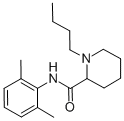Bupivacaine

- CAS No.
- 2180-92-9
- Chemical Name:
- Bupivacaine
- Synonyms
- BUPIVACAINE BASE;MARCAINE;Anekain;Levobupivacaine (Bupivacaine);1-Butyl-N-(2,6-dimethylphenyl)-2-piperidinecarboxamide;1-Butyl-N-(2,6-dimethylphenyl)piperidine-2-carboxamide;LAC-43;win11318;WIN 11318;BUPIVACAINE
- CBNumber:
- CB4413068
- Molecular Formula:
- C18H28N2O
- Molecular Weight:
- 288.43
- MOL File:
- 2180-92-9.mol
- Modify Date:
- 2024/7/25 20:04:51
| Melting point | 107.5-108° |
|---|---|
| Boiling point | 430.65°C (rough estimate) |
| Density | 1.0238 (rough estimate) |
| refractive index | 1.5700 (estimate) |
| pka | 8.09; also reported as 8.17(at 25℃) |
| Water Solubility | 101.5mg/L(25 ºC) |
| InChI | InChI=1S/C18H28N2O/c1-4-5-12-20-13-7-6-11-16(20)18(21)19-17-14(2)9-8-10-15(17)3/h8-10,16H,4-7,11-13H2,1-3H3,(H,19,21) |
| InChIKey | LEBVLXFERQHONN-UHFFFAOYSA-N |
| SMILES | C1(CCCCN1CCCC)C(=O)NC1C(C)=CC=CC=1C |
| CAS DataBase Reference | 2180-92-9(CAS DataBase Reference) |
| NIST Chemistry Reference | 2-Piperidinecarboxamide, 1-butyl-n-(2,6-dimethylphenyl)-(2180-92-9) |
| EPA Substance Registry System | 2-Piperidinecarboxamide, 1-butyl-N-(2,6-dimethylphenyl)- (2180-92-9) |
SAFETY
Risk and Safety Statements
| Symbol(GHS) |    GHS07,GHS05,GHS06 |
|---|---|
| Signal word | Danger |
| Hazard statements | H315-H310-H318-H330-H300 |
| Precautionary statements | P262-P264-P270-P280-P302+P350-P310-P322-P361-P363-P405-P501-P264-P280-P302+P352-P321-P332+P313-P362-P280-P305+P351+P338-P310-P264-P270-P301+P310-P321-P330-P405-P501-P260-P271-P284-P304+P340-P310-P320-P403+P233-P405-P501 |
| Hazard Codes | T+ |
| Risk Statements | 26/27/28-38-41 |
| Safety Statements | 22-26-36/37/39-45 |
| RIDADR | 2811 |
Bupivacaine Chemical Properties,Uses,Production
Uses
Like lidocaine and mepivacaine, bupivacaine is used in infiltration, spinal, and epidural anesthesia in blocking nerve transmission. Its most distinctive property is its long-lasting action. It is used for surgical intervention in urology and in lower thoracic surgery from 3 to 5 h in length, and in abdominal surgery lasting from 45 to 60 min. It is used to block the trifacial nerve, the sacral and brachial plexuses, in resetting dislocations, in epidural anesthesia, and during Cesarian sections.
General Description
Bupivacaine was synthesized simultaneously with mepivacainein 1957 but was at first overlooked because of the increasedtoxicity compared with mepivacaine. When themethyl on the cyclic amine of mepivacaine is exchanged fora butyl group the lipophilicity, potency and the duration ofaction all increase. Literature reports of cardiovascular toxicity,including severe hypotension and bradycardia, areabundant in the literature.91 Bupivacaine is highly bound toplasma proteins (95%), and thus the free concentration mayremain low until all of the protein binding sites are occupied.After that point, the plasma levels of bupivacaine rise rapidlyand patients may progress to overt cardiac toxicity withoutever showing signs of CNS toxicity. The cardiotoxicity ofbupivacaine is a result of its affinity to cardiac tissues and itsability to depress electrical conduction and predispose theheart to reentry types of arrhythmias. The cardiotoxicity ofbupivacaine was found to be significantly more prominentwith the “R” isomer, or the racemic mixture, thus the “S”stereoisomer is now on the market as levobupivacaine.
Mechanism of action
Bupivacaine is a local anaesthetic containing a chiral centre and adopts dextro and laevo forms. The enantiopure l form is less cardio- and neurotoxic and has an equivalent potency to the racemic mixture; therefore levobupivacaine is often preferred to reduce the potential for toxicity. Stereoselectivity describes the differences in response at a given receptor for the different enantiomers (such as the response discussed for S(+) ketamine). The opioid and NMDA receptors also exhibit stereoselectivity.
Pharmacology
Bupivacaine is a chiral compound used clinically for 50 years, with a slower
onset, greater potency and longer duration of action than lidocaine. Initial
benefits of bupivacaine were sensory–motor separation and minimal
tachyphylaxis, unlike repeated doses of lidocaine. However, it has greater
potential for cardiac toxicity, related to its avid binding to and slow
dissociation from cardiac N a+ channels. Inadvertent intravenous
administration may result in systemic toxicity (see later), and it is
contraindicated for intravenous regional anaesthesia.
Bupivacaine is commonly used for epidural administration in obstetrics and
postoperative pain management. A hyperbaric preparation containing
80 mg ml-1 glucose is available for spinal anaesthesia.
Side effects
Common side effects of bupivacaine include:
weakness, long-lasting numbness or tingling;
feeling restless or drowsy;
tremors;
headache, blurred vision;
fast or slow heartbeats;
breathing problems;
chills or shivering;
back pain;
nausea, vomiting.
Bupivacaine Preparation Products And Raw materials
Raw materials
1of3
chevron_rightPreparation Products
| Supplier | Tel | Country | ProdList | Advantage | Inquiry |
|---|---|---|---|---|---|
| Anant Pharmaceuticals Pvt Ltd | +91-8550986868 +91-9485998001 | Haryana, India | 461 | 58 | Inquiry |
| Gonane Pharma | +91-9819380043 +91-9819380043 | NaviMumbai, India | 192 | 58 | Inquiry |
| PANCHSHEEL ORGANICS LTD | +91-9821053955 +91-9324201019 | Mumbai, India | 82 | 58 | Inquiry |
| Dishman Carbogen Amcis Ltd (Dishman Group) | +91-2717420100 +91-8154017093 | Gujarat, India | 90 | 58 | Inquiry |
| Apex Healthcare Limited | +9199825711244 | Gujarat, India | 22 | 58 | Inquiry |
| SG Pharma Pvt Ltd | +91-2227622000 +91-2227622000 | Maharashtra, India | 6 | 58 | Inquiry |
| Ralington Pharma | +91-7948911722 +91-9687771722 | Gujarat, India | 1350 | 58 | Inquiry |
| BDR Pharmaceuticals International Pvt Ltd | +91-2240560560 +91-7718884418 | Maharashtra, India | 206 | 58 | Inquiry |
| Fresenius Kabi Oncology Limited | +91-1243325000 +91-1244885000 | Haryana, India | 22 | 58 | Inquiry |
| AKASH PHARMA EXPORTS | +91-9388123451 +91-9846039283 | Kerela, India | 470 | 58 | Inquiry |
Related articles
- Liposomal bupivacaine: Overview, Efficacy in Postoperative Pain and Safety
- Liposomal bupivacaine provides extended postoperative pain relief with good safety. Adverse effects include nausea, vomiting, ....
- Mar 6,2024
- Bupivacaine: mechanism of action, clinical applications and safety
- Bupivacaine is a local anesthetic that blocks nerve impulses, providing temporary numbness in specific areas of the body.
- Nov 13,2023
- What is Bupivacaine?
- Bupivacaine is the most potent and toxic of all amide anesthetics. It is four times more potent than lidocaine, mepivacaine, a....
- Sep 24,2020





